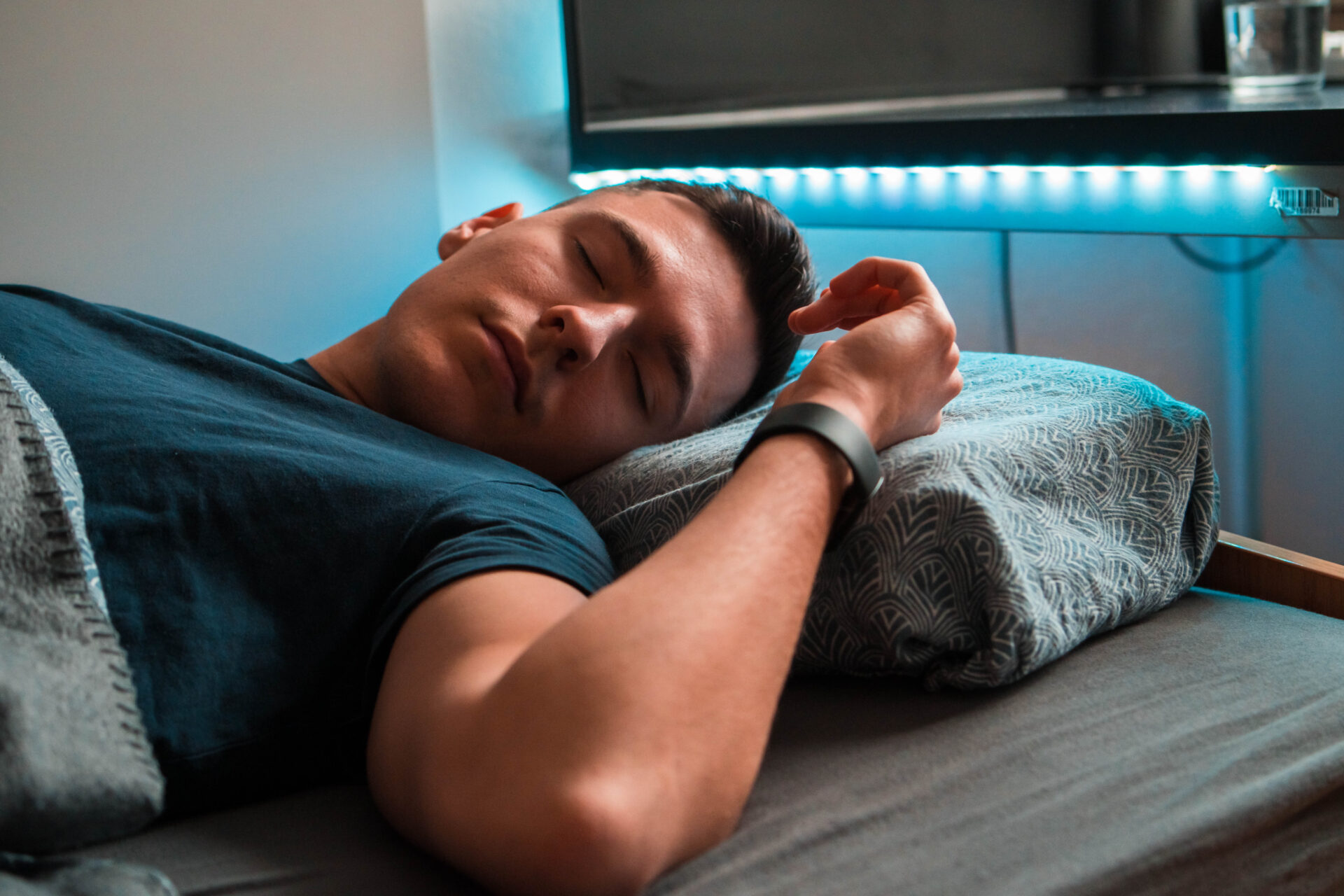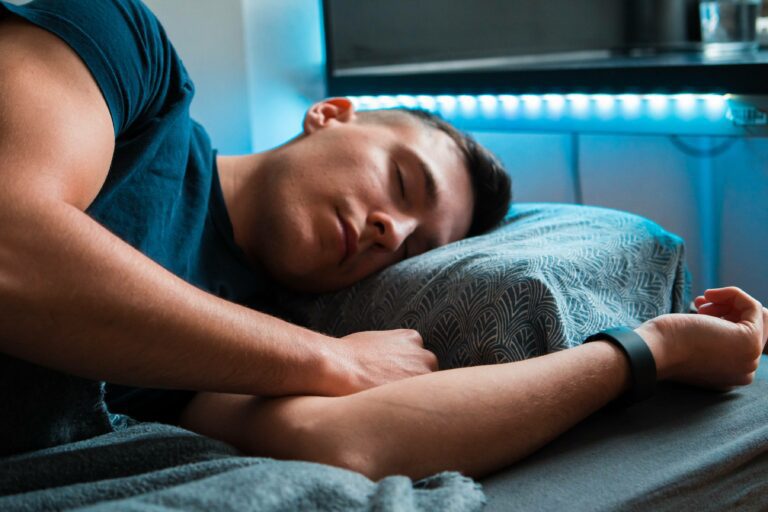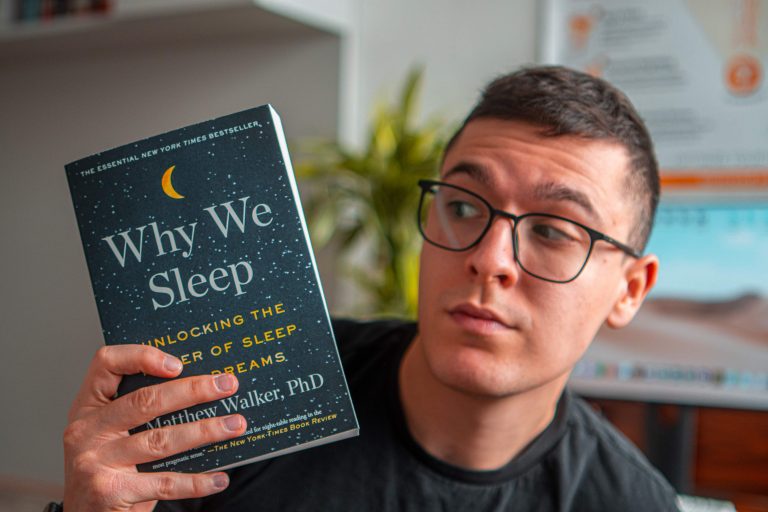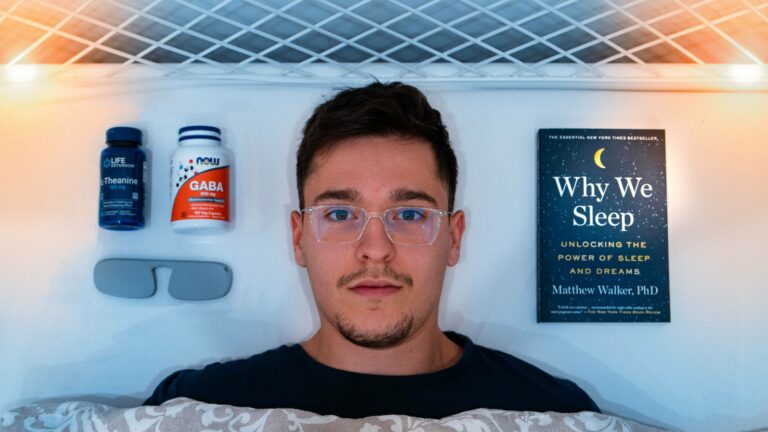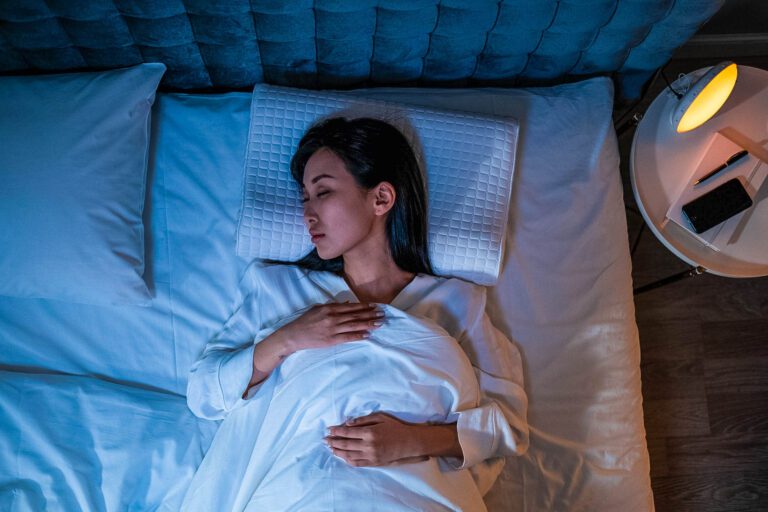Track Your Sleep – 4 Metrics of Sleep Monitoring
Tracking your sleep can provide you with key data points to help you optimize your sleep. Improving the quality and quantity of your sleep can impact your energy levels, mood, and overall well-being.
Sleep monitoring, by helping you to identify patterns, stages, and sleep behaviors can help you make informed decisions about improving your bedtime routine. Whether you’re an athlete, a health enthusiast, or a busy entrepreneur, better sleep quality can drastically improve your performance.
With the scary-accurate sleep trackers available on the market, why not take advantage of improving the number one factor for health? Sleep trackers can help improve sleep hygiene, overcome insomnia, and give you a better night’s rest. This helps you feel refreshed, energized, and ready to take the day.
Sleep Phases – Light, Deep, REM, NREM
Sleep architecture is crucial to understanding one’s sleep quality. It is the structure of your sleep, determined by sleep stages. Sleep stages, or the ratio of the time spent in each stage give valuable insight into sleep quality.
Scientists use electroencephalogram (EEG) to measure brain-wave activity, to determine sleep and wake time. Sleep can be broadly divided into two categories, Non-REM sleep or REM sleep. REM stands for rapid eye movement. (1)
Sleep is broadly divided into non-REM and REM phases, with NREM having three distinct sub-stages. (2) (3)
N1 Phase
N2 Phase
N3 Phase
REM
Non-REM 1 is the first sleep stage with the lowest threshold for awakening, called the transitory phase between being awake and asleep. It takes 1-5 min and constitutes 5% of the total sleep cycle, characterized by a shift from the alpha to theta activity (4-7 Hz)
Non-REM 2 is the second sleep stage in which body temperature drops and muscles relax. With each next cycle, it increases onward by 25+ minutes in duration, composing approximately 50% of total sleep. In N2, memories are consolidated, as EEG detects spindles and K complex associated with it.
Finally, the rapid-eye-movement phase is where dreams happen. The body is atonic and immobile, diaphragmatic breathing speeds up, muscles twitch and the eyes move faster. The REM phase begins after approximately 90 minutes, initially lasting 10 minutes, which increases with each future cycle.
Sleep Benefits
Why is sleep important? In other words, why should you care about improving your sleep quality? Well, sleep is not just important and beneficial sleep is essential.
Numerous studies showed that sleep deprivation leads to weight gain, drives inflammation up, and increases the risk of cardiovascular and metabolic diseases. (4) (5) (6) Poor sleep impairs cognitive processing, reducing the ability to memorize new things, learn and execute. (7) (8)
The benefits of deep sleep and improving the quality of your sleep can lead to
- Improved cognitive function – sleep is essential in consolidating memory, increasing alertness, problem-solving, and executive function. (9) (8) Additionally, it balances numerous neurotransmitters like dopamine and serotonin, which play a crucial role in mood and motivation.
- Better memory – not only does sleep act neuroprotective as it reduces plaque and toxins buildup in the brain, but it also improves memory recall as it’s during sleep that memory consolidation takes place. (10) (11) (12)
- Improved cardiovascular health – sleep deprivation increases cardiovascular disease risk, mainly by increasing sympathetic nervous system activity, increasing hypertension, and lowering [HRV] heart rate variability. (13) (14)
- Fat Loss and Metabolic Health – Sleep helps balance out certain hunger hormones like ghrelin and stress hormones like cortisol, which can reduce overeating. (15) (16) (17) Poor sleep is known to lead in poor metabolic function, low glucose utilization, and higher accumulation of fat. (18) Additionally, sleep supports energy metabolism and enhances insulin sensitivity (19)
Summary: Sleep is key to maintaining metabolic and cardiovascular health. It improves brain health and promotes cognition. It’s essential for regeneration, detox, and cellular repair.
Sleep Patterns – % of Light and Deep Sleep
Sleep pattern defines how you sleep, taking into account the length and quality of your sleep. Specifically, it measures the ratio between sleep phases. One important aspect of tracking your sleep is monitoring the percentage of light versus deep sleep you get.
Light sleep or stages 1 and 2 is a shallower stage of sleep that improves memory consolidation and cognitive function. Deep sleep, or stage 3 and 4 is essential for physical restoration and repair.
Fun Fact
The renowned expert for sleep, Matthew Walker, believes that there isn’t one single sleep factor face that’s vastly more important. All the little processes combined make up the complexity of sleep. Simply put, only optimizing the N3 or deep sleep phase isn’t necessarily the right goal, but striking a good balance [light/deep] may be better.
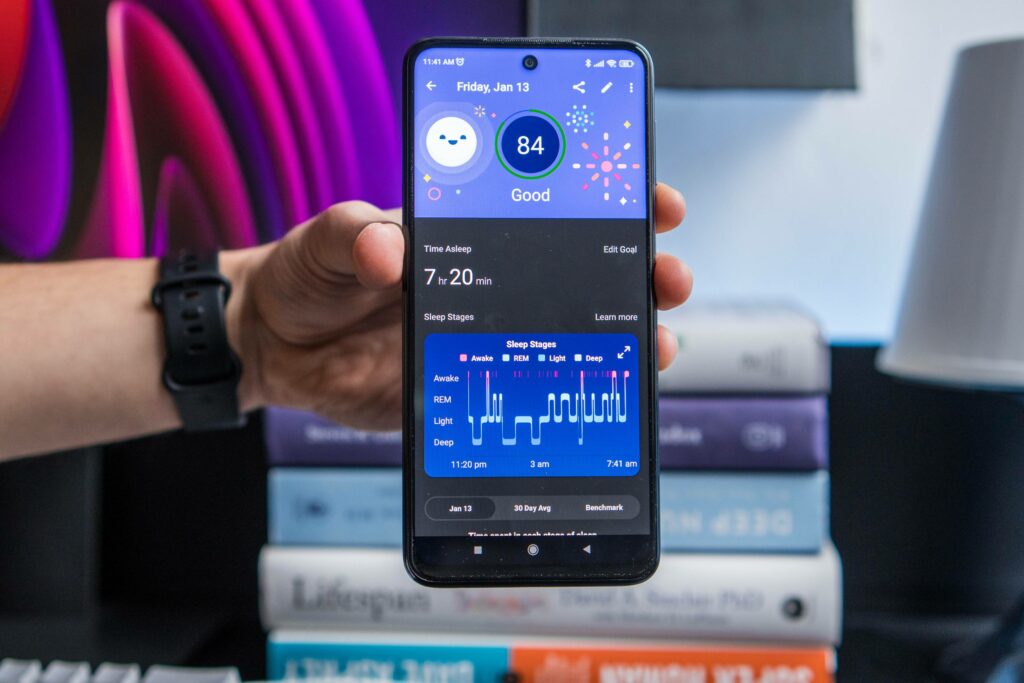
Features of Sleep Trackers
Sleep trackers are devices or applications designed to monitor and track various aspects of sleep. They are often worn on the wrist, like a watch, or placed under a mattress to track movement and gather data about sleep patterns. Some sleep trackers may also include features like noise monitoring, temperature sensing, and heart rate tracking. But what do they measure?
Stages
Duration
Quality
Schedule
tracking sleep stages allows the user to distinguish between light sleep, deep sleep, and rapid eye movement (REM) sleep. By tracking sleep stages, sleep trackers can provide valuable insights into the quality of sleep a person is getting each night.
tracking the total amount of time a person spends sleeping each night. By tracking sleep duration, sleep trackers can help identify whether one gets the optimal 8 hours in bed [sleeping] or is way below.
specific data points put in an algorithm can calculate the sleep quality score. This takes into account the number of times a person wakes up during the night or the percentage of time spent in each sleep stage.
designed to help users maintain a consistent sleep schedule. This shows the actual time we go to sleep and wake up, which is usually underestimated. Additionally, it may include features like alarms and notifications to remind users when it’s time to go to bed or wake up.
Note
Sleep trackers are devices or applications designed to monitor and track various aspects of sleep, including sleep stages, sleep duration, sleep quality, noise levels, and sleeping schedule. They can provide valuable insights into sleep patterns and behaviors, and help users make informed decisions about their sleep routine and habits.
Are Sleep Trackers Accurate?
The most accurate way to measure sleep is EEG. While this is the gold standard, greatly used in laboratory settings, it’s not quite convenient for the average Joe to sleep with electrodes on his head. This is why the market for a sleep tracker has significantly increased. More and more people invest in health trackers, to track measures like sleep, fitness, stress levels, etc.
In terms of convenience, sleep trackers are great. User-friendly devices that collect data points during our sleep. (20) It connects to an app, and voila, you have your results. The only question is, how accurate are they?
While no device will be as accurate as an EEG measurement, and oftentimes many lack reliability (21) there are some scary accurate devices out there. (22) The argument is that a small % of inaccuracy can be tolerated for the well-known benefits (23) of getting sleep insights.
That being said, it’s important to note that research supports contact devices like wearables (ring, band, watch) to be better than just noise-detecting or contactless devices. (21)
What Do Sleep Trackers Measure?
Polysomnography is a more comprehensive sleep test including brain waves (EEG), eye movements (EOG), muscle activity (EMG), heart rate, respiratory rate, and other physiological parameters to provide a detailed analysis of sleep stages.
Sleep trackers can employ various [simpler] technologies to monitor and measure different aspects of sleep. These include:
- accelerometers or gyroscopes to detect movement and change of position during the night
- heart rate monitoring that measures HR throughput and heart rate variability [HRV]
- EDA sensors or electrodermal activity sensors that measure the electrical activity of your skin [conductance]
- Temperature and light sensors to monitor variations in body temperature or exposure to light
- audio monitoring, especially noise-detecting devices that monitor ambient noise or sleep-related sounds like snoring
Fun Fact
Sleep trackers track numerous data points like heart rate, electrical impulses, skin temperature, movement, etc., that are calculated using a smart algorithm to determine sleep measures.
The Most Accurate Sleep Trackers
Some of the most accurate high-quality sleep trackers commercially available today are wearable devices like a ring or a smartband. When scoping the field of sleep trackers, we consider these 4 devices to be a good investment, in terms of accuracy.
Whoop
Oura
Ultrahuman
FitBit Versa 3
Whoop is a smart band with advanced sensors and a complex algorithm designed to measure sleep [stages], recovery, and training. Amongst other measures, whoop emphasizes measuring HRV or heart rate variability as a key data point. Research at the AIS put Whoop to the test, scoring at 99% and 99.7% in accuracy in HRV and HR respectively. (24) (25) (26)
The popular ring specifically designed for sleep tracking. Oura claims to have research-grade sensors that monitor heart rate, stress, sleep, activity, and temperature trends accurately. At The Pulse Blog, you can find a vast array of research using the Oura ring. (27)
claiming to be the most comfortable and lightweight ring, the Air model measures heart rate, HRV, and blood oxygen saturation. Additionally, it has infrared PPG or photoplethysmogram sensors and combines data points to create a sleep index score. (28)
A smartwatch that tracks sleep via motion and heart rate sensors. Of the 4 analyzed trackers in this study, it showed the highest reliability. (29)
Some honorable sleep tracker mentions are also the likes of Apple Watch Series 9, Fitbit Inspire 3, Withings Sleep, Biostrap EVO, Muse S, Garmin Venu 3, and Garmin Vivoactive 5.
There are other types of sleep trackers like mattresses, noise-detecting devices, and electrodes. We wish you a good night’s sleep… After you read this full article, of course.
Note
Our top two picks for the most research-backed, accurate, and advanced sleep trackers include Whoop band 4.0 and Oura ring.
Benefits of Sleep Monitoring
How can the use of sleep trackers help you improve your sleep and overall health?
- Increased awareness of sleep patterns and habits. By tracking sleep data over time, individuals can gain a deeper understanding of their sleep patterns and identify any detrimental behaviors This can include things like the time of day that a person goes to bed, the length of time it takes to fall asleep, and the number of times a person wakes up during the night.
- Ability to identify factors that may be affecting sleep quality. This can include things like noise levels in the bedroom, the temperature and humidity of the room, or the use of electronic devices before bed. By tracking sleep data and analyzing it alongside other factors, individuals can identify any potential issues and make changes to their sleep environment or routine to improve sleep quality.
- Track your progress over time. By regularly tracking sleep data, individuals can see how changes to their sleep habits or routines are impacting their sleep quality and make any necessary adjustments. Seeing how real habits affect our sleep in a quantifiable way can motivate us to change behavior because we have data to prove it.
Conclusion
- Sleep Tracking offers valuable insight for sleep optimization. By tracking sleep we can see the effect of our behavior [light, diet, alcohol] and sleep environment [cold, dark, quiet] on sleep quality.
- Technology: Sleep trackers use various technologies that collect data points on heart rate, HRV, temperature, movement, and blood oxygenation. This data is calculated in a complex algorithm to provide an overall sleep score.
- Data Points: Sleep trackers measure sleep schedule, sleep phases, and sleep duration – which all contribute to understanding sleep quality and efficiency.
- Accuracy: The gold standard for sleep measuring is EEG. However, newer sleep trackers can offer very accurate results using advanced sensors, while being way more convenient to use.
- Top Sleep Trackers: Among the most accurate, Whoop Band 4.0 and Oura Ring stand out, with Ultrahuman Ring and Fitbit Versa 3 being great alternatives as well.

